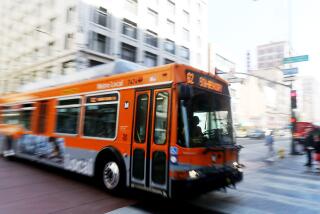Violations surge after O.C. toll roads end cash option
- Share via
Orange County’s transition to making its network of toll roads cashless has now resulted in more than 13,000 violations a day — a figure that has prompted the toll agency to ease first-time penalty fees through the summer.
The Transportation Corridor Agencies closed down its tollbooths in mid-May in favor of a cashless system in which commuters would either use transponders or go online to pay tolls.
But that change appears to have caused confusion with some commuters, causing the number of violations to nearly double from the usual 7,000 each day.
“It was obviously more than we had anticipated,” said agency spokeswoman Lisa Telles. “We want to educate the consumer on how to use the toll road.”
To ease the transition, the toll agency is waiving a $57.50 penalty fee for first-time violators at least through Labor Day, provided they pay the toll within 30 days of receiving the violation.
Under the cashless system, motorists without accounts are supposed to pay one-time tolls online within 48 hours of their trip or be hit with a penalty.
“We’re trying to make sure that first-time users are not penalized because they’re just not familiar with the system,” said Orange County Supervisor Todd Spitzer, who serves on two toll agency boards.
Before the changeover, the agency had been hard at work to spread the message among groups like the county’s visitors bureau, hotel concierges and local residents, Telles said.
But apparently not everyone had gotten the word yet.
Drivers were pulling over on the roadside ahead of the tolls, trying to figure out how to pass through without getting in trouble, Spitzer said.
In Spitzer’s view, information on the varied methods of payment have not been presented well enough for drivers who range from first-time visitors to daily users.
Even drivers who use the toll roads often, such as himself, may not be able to decipher it, Spitzer said.
“You can’t possibly communicate all these messages simultaneously at 65 mph,” he said.
Between now and Labor Day, the Transportation Corridor Agencies plans to monitor data and continue to make improvements. It will then evaluate whether a longer grace period is needed to ensure that drivers understand how the new pay system works, Telles said.
In the meantime, to further aid the transition, additional signs will be installed and messages will be flashed on the changeable freeway information boards. Ten additional customer service representatives are also being hired temporarily.
Spitzer suggested that a dial-in voice recording should be implemented.
Since the changeover, about 13,500 violation notices had been sent out daily, agency spokeswoman Lori Olin said. An estimated 250,000 people use the 73, 133, 241 or 261 toll roads each day.
Information about the payment options can be found on the agency’s website.
More to Read
Get the Latinx Files newsletter
Stories that capture the multitudes within the American Latinx community.
You may occasionally receive promotional content from the Los Angeles Times.






